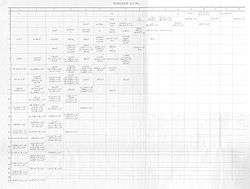Ternary quartic
In mathematics, a ternary quartic form is a degree 4 homogeneous polynomial in three variables.
Hilbert's theorem
Hilbert (1888) showed that a positive semi-definite ternary quartic form over the reals can be written as a sum of three squares of quadratic forms.
Invariant theory

The ring of invariants is generated by 7 algebraically independent invariants of degrees 3, 6, 9, 12, 15, 18, 27 (discriminant) (Dixmier 1987), together with 6 more invariants of degrees 9, 12, 15, 18, 21, 21, as conjectured by Shioda (1967). Salmon (1879) discussed the invariants of order up to about 15.
The Salmon invariant is a degree 60 invariant vanishing on ternary quartics with an inflection bitangent. (Dolgachev 2012, 6.4)
Catalecticant
The catalecticant of a ternary quartic is the resultant of its 6 second partial derivatives. It vanishes when the ternary quartic can be written as a sum of five 4th powers of linear forms.
See also
References
- Cohen, Teresa (1919), "Investigations on the Plane Quartic", American Journal of Mathematics, The Johns Hopkins University Press, 41 (3): 191–211, doi:10.2307/2370332, ISSN 0002-9327, JSTOR 2370332
- Dixmier, Jacques (1987), "On the projective invariants of quartic plane curves", Advances in Mathematics, 64 (3): 279–304, doi:10.1016/0001-8708(87)90010-7, ISSN 0001-8708, MR 888630
- Hilbert, David (1888), "Ueber die Darstellung definiter Formen als Summe von Formenquadraten", Mathematische Annalen, Springer Berlin / Heidelberg, 32: 342–350, doi:10.1007/BF01443605, ISSN 0025-5831
- Noether, Emmy (1908), "Über die Bildung des Formensystems der ternären biquadratischen Form (On Complete Systems of Invariants for Ternary Biquadratic Forms)", Journal für die reine und angewandte Mathematik, 134: 23–90 and two tables.
- Salmon, George (1879) [1852], A treatise on the higher plane curves, Hodges, Foster and Figgis, ISBN 978-1-4181-8252-6, MR 0115124
- Shioda, Tetsuji (1967), "On the graded ring of invariants of binary octavics", American Journal of Mathematics, 89: 1022–1046, doi:10.2307/2373415, ISSN 0002-9327, MR 0220738
- Thomsen, H. Ivah (1916), "Some Invariants of the Ternary Quartic", American Journal of Mathematics, The Johns Hopkins University Press, 38 (3): 249–258, doi:10.2307/2370450, ISSN 0002-9327, JSTOR 2370450